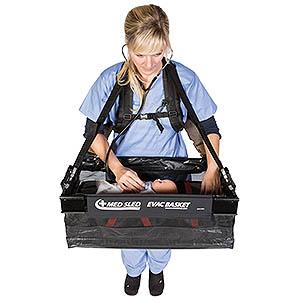
If an emergency strikes in a child care facility or a hospital where children are being cared for, the task of getting everyone out safely is challenging. Because babies and children all need extra assistance in an emergency situation any evacuation is going to take longer than usual – which is why having an escape plan and the right emergency equipment is vital.
Today, over 900,000 children attend formal child care. Childcare centre managers and staff have an ethical and legal responsibility to provide a safe environment for all children in their care. It’s up to them to make sure that if an emergency strikes, the necessary escape equipment is adequate and available and escape plans are effective and practised regularly.
In any emergency situation, fully evacuating a hospital is a mammoth task. Planning ahead helps make the task easier and less stressful if it ever happens. By making sure all staff are well-drilled in what to do, and providing them with suitable equipment to use in an emergency, the likelihood of a successfully emergency evacuation is much higher.
Planning An Escape
Every home and workplace in Australia should have a detailed emergency escape plan, and this is especially true of any facility that cares for children. Your escape plan should clearly show the floor plan of your facility, all the exits, a meeting place outside the building and the escape route from each room. Once your plan is complete, be sure to practise it and put it on display where everyone can see it.
For childcare centres and hospitals, you’ll also need to put some thought into how you’ll evacuate children quickly and safely in an emergency, including those with additional needs and medical conditions.
In child care centres, the child to staff ratio also plays an important part in planning your escape. As of January 2016 the ratios in Australia are:
- 1:4 for children under 24 months (all states and territories)
- 1:5 for 24 -36 months (all states and territories except Victoria which is 1:4)
- 1:10 for children older than 36 months up to school age (NSW, Tas and WA, and in centre-based pre-schools and disadvantage preschools in SA) or 1:11 in ACT, NT, QLD and VIC, plus, preschools other than disadvantaged in SA.
Hospital staff are faced with a similar problem – lots of patients to evacuate and not enough hands. And because all of the patients are suffering from a medical condition, some of which are serious or life-threatening, they will most likely need to have their medications or medical equipment that they rely upon evacuated with them.
Escape plans for both hospitals and child care centres must detail the process and logistics of how the evacuation of children will happen. The good news is, that there are emergency tools available that will make the task a lot easier.
Emergency Escape Tools For Babies And Children
A well-stocked emergency kit for any home or workplace should include items such as torches, first aid kits, glass-breakers and evacuation masks. But for childcare centres and hospitals, there’s a few additional items that can make a massive difference in the time it takes to evacuate small children.
As the head of a maternity/ children’s department or childcare centre, you are responsible for the safety and well-being of all of the children. You work every day to ensure they are well cared for, but what do you do in an emergency? What if the worst happens, and a fire breaks out? How will you get all of the children to safety quickly?
In the case of an evacuation, you can only carry two kids at a time down the stairs and out to safety. Time is of the essence, and the more time you spend going back and forth, their safety could be in danger.

During an emergency, you can evacuate several babies and toddlers in safety at the same time by using the Baby Mover.
The Baby Mover is made of fire retardant material that has been extensively laboratory tested.

Can be easily dragged by one or two rescuers. After positioning the baby onto the mattress, you fixate the arms and belly. Secondly, you fixate the head with the head blocks. After doing this, you cocoon the baby with the flap. Now you can start the evacuation.
The Med Sled and the Med Sled Bariatric are essential pieces of emergency equipment for hospitals, nursing homes and anywhere that non-ambulatory people are located. It allows for fast and safe evacuation of those who cannot exit independently, and its roll and drag method means that no heavy lifting is required.

The Med Sled Infant Insert is suitable for babies aged 0-5 months and it holds up to three babies. Plus, it also has a cut out at both ends that is suitable for carrying neonatal intensive care unit equipment and an oxygen tank if required.


Planning And Preparation Is The Key
If you work with children, whether in a childcare centre or a hospital if an emergency strikes, their life is in your hands. While you cannot predict what type of emergency you may face, when you have an escape plan in place, and the right emergency equipment to support you, you’ll be prepared and confident to face any challenge that arises.


